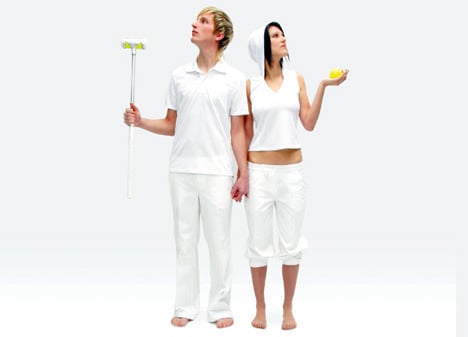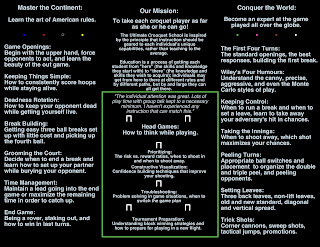Our Solomon Trophy test match started as a MacRobertson Shield format with 6 players per team, each player playing 2 singles matches (best of 3) and the three doubles teams playing each of the other three teams. The doubles partnerships fell into place for us as Ron and David had played together before and Paul and I had played often in the West, leaving Danny and Stewart as our best ranked team.
[I get a bit verbose here, reporting the first few rounds in detail. This only attests to the excitement in play, while many games were triples to form, some had amazing back an forth and a few had 6 (or more) peels.]

(The bowler turned US croquet player
topiary was named George Bush)
We started with a bit of ceremony and a day of doubles matchups. Ron and David were quickly overpowered (possibly thanks to their late arrival and lost bag) by Jonathan Kirby and Ian Lines with two +26tp games, impressive. Danny and Stewart fared slightly better, but only slightly. Ian "digger" Burridge and David Maugham won with a +25tp, +26tp match. Meaning Danny and Stewart got a wicket! Paul and I were matched up with Keith Aiton and Tony LeMoignan who dispatched with us +26tp on the fifth turn of the first game. We didn't get to take croquet. In the second game, Paul failed to hit on third turn and Tony hit a 20 yarder to get going, but he missed 3-back! Paul took the first break around and while I failed ot get any peels, Keith missed the hit in allowing Paul to finish a +18 game putting the Yanks on the board! With our spirits high, we watched an instant replay of the first game as Keith ran another fiifth turn triple for the +26tp win in which we did not take croquet.

(These four beautiful courts were immaculate
and fast, thanks to Paul Rigg)
After round one we were 0-3 in matches 1-6 in games and 27-156 in wickets. Ouch.
Round two saw Burridge and Maugham beat up on Ron and David, but Ron did take a nice 9 hoop break around bringing the scores to +26tp, +17tp. Danny and Stewart took a game off of Keith and Tony but still lost +26tp, -26, +17.
In our match against Kirby and Lines, Paul played the archtypal hero. In the first game, Paul hit in on fourth turn only to miss wicket 2. After Kirby ran a beautiful break, Linesy missed a hampered shot after just dribbling through wicket 6. Paul took his ball around to 4-back and willed Jonathan to miss for me. I was working on a delayed triple, getting the first peel before wicket 6, but only jawsing the penultimate peel before making 4-back. I failed to get Paul into peeling position at rover and asked if he minded me trying a post-humous peel (peeling rover after I had already made the wicket myself). Paul replied, "I don't see why not." Only to watch me jaws the peel and follow with, "I guess that's why not." I spread the balls out and staked out my ball (in retrospect, a bad decision since they were both for wickets that allowed us balk line lifts). After hitting in, they set a nice leave and Paul was playing one-legged. Paul decided to put his hero hat on and hit a 21 yarder; but alas, after making rover, he had no shot on any ball (hampered). Paul decided to go for the peg from 7 yards, through the wicket. Sure enough, he hit giving us the +11 victory. The second game was quite defensive with the first three hit in's resulting in only two wickets, but I was able to set a trap and make my way to 4-back. After the missed lift shot, Paul ran a form delayed triple until he was left with a horribly angled peel at rover. Having yet to hit the near ball at rover, Paul decided to try an Aspinall peel (while jawsing peelee, one lats the sriker ball roll cannon the ball through on the same shot) that Jim Bast had showed us the day before. It worked wonders and Paul secured our first match +11, +25tp!
We all enjoyed a wonderful cookout at David Maugham's house in and the brits offered to change the format. We were so ahead of schedule we could play best of 5 singles matches or each have three best of 3 matches. After a bit of back and forth about what served us best (trying to win the test match or playing more games and developing) we decided to each play three singles matches.
Our first singles matches had some predictable results as the British team had much more depth. The lowest ranked Brit (Burridge) was ranked #38 in the world (our best, Danny, was #42) while our lowest ranked player (Ron) was #90.
Paul put up a great fight, but lost -10tpo, +24tp, -8tpo to Tony. Digger had a straight triple in game tow beating David +3tp, +23stp. Jonathan Kirby didn't give Ron much to play with winning +25, +26tp. Stewart had a close one with Linesy, but lost +26tp, +9. My match against David "the Beast" Maugham started well as I managed a very delayed triple +25tp. After ruining my first break chance in game two he decided to Popp (peel me through 1 and 2) my ball in the so I was for hoops 3 and 4, very small chance of getting a triple. It proved overkill as I missed the lift shot and he finished +21tp. In the third game he tried to sextuple, but only missed 3-back after getting four peels. I took a ball around only to watch him hit in and win in two turns, -25tp, +21tp, +17. Danny proved to be the best prepared as he battled with Keith (#4 in the world at the time) and won +13, -6tp, +25tp!

(The Solomon Trophy with our mascots)
Danny continued to take down giants. He played in a near perfect match against the Beast -26tp, +26tp, +26tp as well as taking down Linesy -17tp, +17tp, +25 for a perfect 3-0 record! Paul, Ron, and David were all defeated, while David got a nicce +26tp victory over Tony LeMoignan.
Keith rebounded from his loss to Danny by beating up on me +11tpo, +26tp. My last match against Ian was most unusual.
In the first game, I managed to take the first break around only to watch him hit in and do the same. His second break didn't go so well as he missed position at 2, and after getting it going again he could not get any peels. After a missed lift shot he managed to blob 4-back! I could either play the front ball with an easy break to the peg or play a leave for the back ball. I chose to go to the peg, but he hit the leave and pegged two balls out. Now it was 1v1 with him for 4-back while I was for hoop 1. He actually managed to make 4-back before I made hoop 1, but he had to be careful making punultimate with me around wickets 2 and 3. I managed to get nice close position at 3 as he "deemed" (passed) in corner 2. I decided to be coy and I played into the jaws, then more than halfway through the jaws at three while he waited in corner 2, deeming all the while. I was able to "turn the corner" with three well played shots; making 3 while setting up at 4, making 4, and getting decent position at 5 all in one turn. As I prepared to do the same through 5 and 6, I got him to shoot at me in the jaws at 5. When I eventually set up at 1-back he played to the middle of the north boundary, only 10 yards away! Just the opportunity I was waiting for. Of course, I missed him, allowing him to make penultimate, put me back on th enorth boundary and get position at rover. I had no play but to hit him, now 24 yards away, so I did. I got poition at 1-back and he went back in front of rover. With no margin for error, I made 1-back, hit the 9 yarder I had at him, and ran the sloppiest 2-ball break around to penultimate. I had no rush to rover, so I took off and made rover and escaped to the East boundary. He took position at rover and I could play north of the peg, or shoot at him... I hit him from 13 yards and won, having overcome a 10 hoop deficit in one-ball.
The second game was much more ordinary. I was able to run around on the third turn (three-ball breaks are much easier than two ball breaks, let me tell you). And he missed the lift shot at my three ducks-in-a-row. While I braved multiple heavy downpours, I managed to get my three peels and as I rounded 4-back, a camera crew arrived and was taping me. Not wanting to bore them with ordinary footage, I put my first ever 5th turn triple at risk by just barely running penultimate and having to get Danny to ref a 5 yard sweep shot. I thought, "Just great, the Brits can watch me miss on the news." Thankfully I hit and finished the triple giving me a +2, +26tp victory over #7 in the World.

(The British team, left to right: Ian Lines,
David Maugham, Tony LeMoignan, Ian Burridge,
Jonathan Kirby, Keith Aiton and officiant Colin Irwin)
Meanwhile, Stewart had the most eventful matches against the Beast and Keith. David Maugham showed Stewart Fulford-like perfection with a +26 sxp, +16tp victory. As the matches finished and an actual crowd appeared, Stewart had to take on Keith Aiton. In a scrappy game 1, Stewart gave us something to cheer for with a +19 win over #4 in the world. But Keith took charge with a delayed sextuple ending with a straight triple (rush peeling through 4-back after making 3-back). Stewart started out well in game three, but missed 3-back. Just when we thought we'd seen it all, Keith started the third game with a very wierd play, double loading 3. We all wondered if he would try a quadruple peel out, but Danny said, "Uh-oh, he's gonna do an octuple!" Sure enough, we five Americans sat together watching a near perfect octuple which ended up ahead of Keith's sextuple as he peeled penultimate on the way to 4-back. As Keith pegged out we five students of the game, lead by our team captain, Danny Huneycutt, walked out to the bounadary string and bowed to the master.
While we lost the match 21-6, we played well and learned a lot. We also gained a new US team supporter, a British defecter:

(Our newest fan)

































